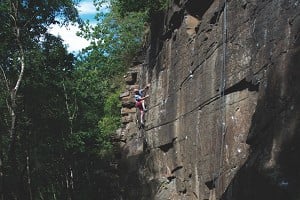
The vote is to be held on the 25th April at the BMC AGM held at Plas y Brenin, Snowdonia.
The current President of the BMC Charles Clarke will retire and the candidates hoping to replace him are Rab Carrington (currently Vice President) and Doug Scott.
See the bottom of this web page for details and how to vote and more about the two candidates.
Read: Supporting Statement from Rab Carrington : Candidate for BMC President
Supporting Statement from Doug Scott: Candidate for BMC President
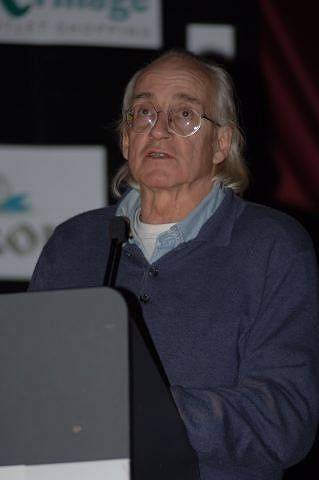
I am passionate that we follow up the demand abroad whenever it is made for foreign climbers to know more about British climbing traditions. The BMC should encourage this wherever possible, mainly through international exchanges and support for the creation of areas reserved for traditional climbing.
Though it is 15 years since I was vice-president of the BMC, my subsequent detachment from its day-to-day affairs may have an advantage if only to enable me to see the wood from the trees and relate some of our internal problems to life in general. Age also brings a degree of experience that helps when deciding which direction to take. For instance, if you are old enough to recall the taste of food pre-industrial farming you will remember how sweet and tasty and, in fact, nutritious food was before chemical supplements were applied to soils depleted of essential nutrients, before food itself was dumbed down and devalued. The warning to climbing here should be obvious.
Just to continue the gardening metaphor a little longer – especially since some wise climbers are now growing their food (Rab included) - I have just taken delivery of 1 ton of rock dust for my vegetable plot. But I've lost none of my love for its less dusty form – the unsullied rock of our UK crags. So I am a traditionalist...but I want to see the BMC support and embrace all new ideas that ensure traditional climbing thrives alongside indoor wall climbing, sport climbing and competition climbing.
Traditional Climbing
In diversity there is great strength. The BMC needs to plan for diversity for traditional climbing, sport climbing, indoor wall climbing and the associated indoor competition climbing.
Sport climbing with bolt protection (and yes, I've done it) is a very enjoyable valid facet of our sport providing it takes place in agreed areas where it is impossible to put in protection and where it does not compromise traditional climbing.
Protecting your own life on a free climb requires imagination, resourcefulness, and the development of skills - an art form. It also introduces the element of uncertainty, always the main ingredient of a memorable climbing experience. To preserve these qualities, the bolt fund established for equipping and re-equipping sport routes should also be used to fund the removal of inappropriate bolts by paying toward the expenses of those co-opted for this onerous job.
The BMC website and publications need to stress that traditional climbing is where we started and that it is still far and away the most popular aspect of climbing in the UK, with the majority of climbers placing their own protection. Summit magazine and the website must strike a balance in representing British climbing at its best and as it is practiced by the majority. For example, it's time to call a halt to one image after another of a climber only inches away from a bolt on slate or limestone, or dry tooling under a Scottish roof, just because the image looks spectacular.
Access
As far as I am concerned the BMC originally came into being for three main reasons: to represent the clubs, to test gear, and to gain access to the crags.
Access remains the most important area of BMC work and possibly should be strengthened with additional personnel co-opted from other duties (subscriptions?). There is still much to do. We all look forward to a satisfactory conclusion of The Marine and Coastal Conservation and Access Bill presently in the House of Lords thus ensuring a coastal path around the whole country.
The BMC should review the footpath work being undertaken in recent times. With the use of mechanical diggers and helicopters some footpaths have become intrusive highways across the landscape. Do we want this “urbanization” of our national parks? Those of us in the Lake District yearn for the days of Ray McHaffie and his team, toiling with pick and shovel but sensitive to the lie of the land and their impact upon it.
The BMC should concern itself not only with collecting rubbish from crags but also consider cleaning up the crags themselves by gardening and removing trees that have overtaken the crag after consultation with the relevant authorities. Obviously a balance has to be struck here between the needs of climbers, the local community and wildlife.
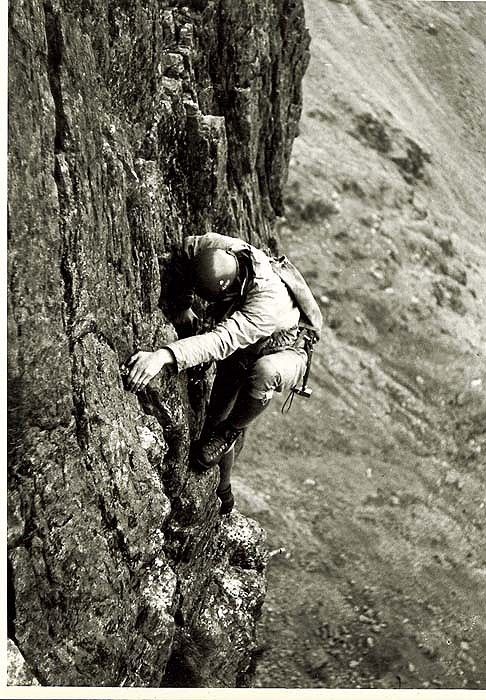
The BMC and the Clubs
Although membership of climbing clubs seems to be on the increase nevertheless individual membership of the BMC is two thirds more than club membership. To some extent the influence of the clubs has been sidelined, although as it happens at the moment committee folk from clubs do tend to dominate the affairs of the BMC. If the Clubs wish to increase their influence long-term then more consideration may need to be given to BMC business being included on their own committee agendas as it is a two way process.
The BMC needs to take another look at the voting system. The pendulum has swung away from the Clubs since the ending of the block vote and towards the individual members. This has potentially given far more power to the BMC Executive. One consideration is that the BMC should have a quorum of, say, 10% of its membership before decisions are carried. A formula whereby part of that quorum could be club membership is worth examination.
If the tendency continues for the BMC to be less of a council representing the Clubs and more of a club in its own right then perhaps the name should change to reflect this - The British Mountaineering Club?
Training and Awards
Thankfully the BMC emerged from the 1970s training debates very influential on the Mountain Leader Training Board and more recently with the Single Pitch Award and the Climbing Wall Award. It is important that only those grounded in traditional climbing should receive these awards. Such people are well placed to help indoor wall climbers make the transition from the controlled indoor environment to the unpredictable outdoors without expecting or demanding pre-placed protection, lower offs and top rope facilities. At every opportunity the BMC should use its influence on training to emphasise traditional climbing especially at the National Mountaineering Centre - Plas y Brenin. Climbing should not become overly structured and hierarchical; there should always be an anarchical element ensuring that climbers always take responsibility for their own actions and ultimately their lives.
Climbing Walls
Having opened half a dozen walls and frequently enjoyed using them on my travels and here in Cumbria with my kids it could be said I am pro climbing wall. Because I use them, I do know their limitations and notice the change of attitude to rock after several wet weather visits to walls and having got used to pre-placed protection. So I appreciate all the BMC has been doing to help with the move from indoors to outdoors and that effort should only be encouraged.
This is a real problem. It's like learning to drive on a racing circuit where one can achieve great speed in a basically safe environment and then being put out on the open road with all the other road users and hazards to consider. Similarly the indoor climber, although very gymnastic, needs to learn new strategies and techniques to survive in the great outdoors. The BMC officer dealing with climbing walls should have as part of their job description a requirement to comes up with all manner of ways to facilitate this transference.
Competition Climbing
Whatever the pros and cons of competition climbing and whether climbers find the whole idea an anathema, there is no real problem if competitions remain indoors. There are approximately one thousand mainly young people who take part in competitions and this sizeable minority has to be catered for. However the BMC does need to review its degree of involvement with competition climbing to see if there is a more satisfactory formula whereby the BMC still has influence but without a cost out of proportion to the numbers involved. Consideration should be given to differentiating between climbing walls and competition climbing by having a different BMC officer dedicated to each.
Climbing and the Olympics
Many climbers have put two and two together having read of Dame Kelly Holmes and the BMC, the BMC at Number 10 and the run up to the Olympics in 2012. There is definitely a faction in favour of climbing associating itself with the Olympics, ostensibly to attract more Government money. It should be noted however that there are numerous hoops for all minor sports such as ours to negotiate and in fact some have recently been removed from the Games. It would seem that there is little chance for competition climbing to become an Olympic event and no chance at all for traditional and sport climbing. It may be that in some way climbing can become associated with the Olympic Movement in general and a debate probably needs to be opened up to see where the majority of climbers stand on this issue.
The BMC should ensure its members are aware that the International Federation for Sport Climbing, IFSC, is absolutely nothing to do with sport climbing. The IFSC is the governing body for indoor climbing competitions that broke away from the UIAA hijacking sport climbing in name only, much to the chagrin of sport climbers on the continent. The BMC was in at the start of the IFSC and needs to decide what further involvement it has with regards to IFSC stated policy to pursue the Olympic ideal - again this needs to be opened up to discussion.
Government Money
He that pays the piper generally calls the tune - but with the right amount of lobbying the tune can be changed. The BMC needs to get through to politicians just what climbing is all about; that there is an alternative to competition when it comes to improving the health of the nation and that UK climbing can be admired throughout the world without it ever being competitive. The Government should recognise that British Himalayan climbing especially, is renowned and would be more so with grants towards the enormous costs involved. Grants should be particularly directed to young people getting started and going on their first trips.
Commercial Aspects
Many of the services provided by the BMC are commercial in nature - insurance, guidebooks and training - or have a commercial element attached to them. The BBC has a separate yet supporting body, BBC Enterprises, which has just acquired the Lonely Planet Guide Books; should the BMC similarly separate and expand its commercial side to become less dependent on government funding? This should be looked into.
BMC Office
We have a dictum in Community Action Nepal to do more with less since we are a charity dependent on donations and goodwill that would evaporate if we were seen to be profligate. Similarly the BMC must be seen to utilise its human resources wisely to continue to have the hard won respect of climbers everywhere.
Doug Scott, CBE
BMC AGM - How to use your vote
As a BMC member you are entitled to vote at the Annual General Meeting (AGM) - even if you are not able to attend in person. To register your vote simply complete the proxy voting form. Amongst other things, this years AGM features a contest for President between Doug Scott and Rab Carrington and a proposal for Audrey Seguy to become a new Vice-President of the BMC.
Q. How can I get hold of a proxy voting form?
A. The proxy voting form was sent out with Summit 53 and is also available to download here.
Q. What are the voting procedures?
A. Find out all about the voting procedure here.
Q. How can I find out more about the candidate for BMC President?
A. Read more about Rab Carrington and Doug Scott's proposals here.
Q. How can I find out more about the AGM?
A. The AGM is on 25th April at Plas y Brenin. Full details here.

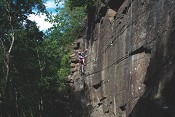
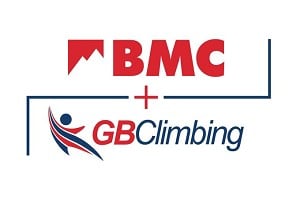
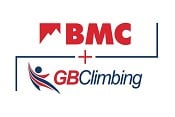
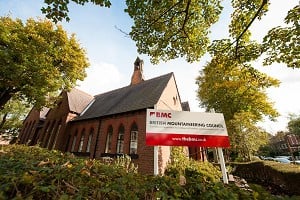







Comments